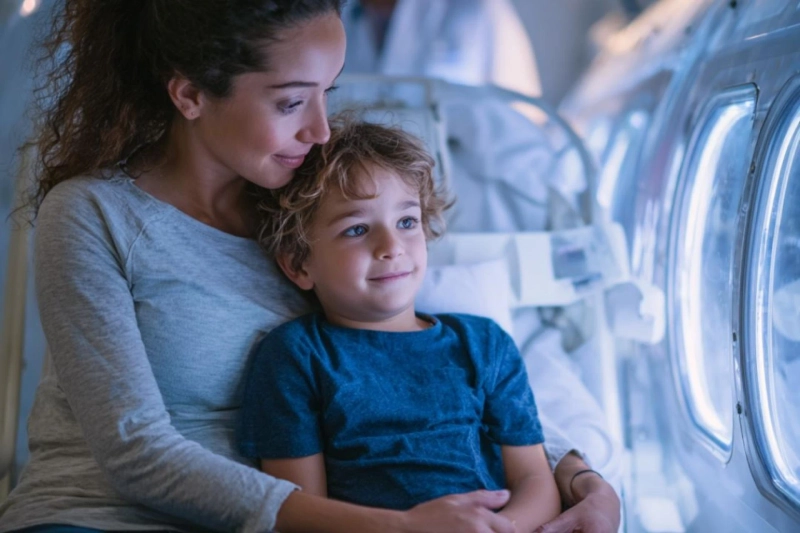For families navigating the world of autism, every new therapy offers a mix of hope and caution.
Among the wide range of interventions available, hyperbaric oxygen therapy for autism (HBOT) has drawn attention as both a promising and controversial option.
Parents, caregivers, and professionals continue to ask: Does it really help?
Let’s take a closer look at the science, the stories, and what’s still unfolding.
Understanding Autism Spectrum Disorder (ASD)
Autism spectrum disorder (ASD) affects about 1 in 36 children in the U.S., according to the Centers for Disease Control and Prevention (CDC) (CDC, 2023).
It is characterized by challenges in social communication, restricted interests, and repetitive behaviors. Because ASD varies widely in how it presents, treatments often need to be individualized.
Traditional interventions include behavioral therapy, speech therapy, occupational therapy, and, in some cases, medication. Increasingly, parents are exploring complementary options like diet, sensory integration therapy, and HBOT to see if they might improve quality of life.
What Is Hyperbaric Oxygen Therapy (HBOT)?
HBOT is a medical treatment in which individuals breathe pure oxygen in a pressurized chamber.
By increasing both oxygen concentration and pressure, HBOT delivers higher levels of oxygen into the bloodstream and tissues.
This process is well established for conditions like decompression sickness, non-healing wounds, and carbon monoxide poisoning (FDA).
Why Consider Hyperbaric Oxygen Therapy for Autism?
One theory behind HBOT’s role in autism is that it may address some underlying biological issues observed in many children with ASD, such as:
- Hypoperfusion (reduced blood flow) in certain brain regions
- Neuroinflammation that may interfere with brain signaling
- Oxidative stress, which affects cellular health and energy
By increasing oxygen availability and potentially reducing inflammation, HBOT might support better brain function and cellular repair.
What the Research Says
Scientific evidence on hyperbaric oxygen therapy for autism is still evolving:
Controlled Studies:
A 2009 randomized, double-blind, controlled trial published in BMC Pediatrics reported improvements in social and cognitive awareness in children who underwent HBOT compared to controls.
Mixed Results
Other studies, however, have shown less dramatic outcomes. A 2016 review in Undersea & Hyperbaric Medicine concluded that while HBOT is safe, more large-scale, high-quality trials are needed before firm conclusions can be made.
Anecdotal Evidence
Many parents have shared powerful stories of improvements in speech, attention, and behavior after HBOT.
While these reports inspire, they also highlight the importance of individualized responses—what works for one child may not work for another.
What Parents Should Know Before Trying HBOT
- It’s Off-Label: HBOT is not an FDA-approved treatment for autism. Families should be aware of this when making decisions.
- Safety Profile: HBOT is generally considered safe when supervised by trained professionals. Possible side effects include temporary ear pressure or fatigue.
- Costs: A typical session can range from $100 to $250, and treatment often requires 20–40 sessions. Insurance rarely covers it for autism
- Individualized Approach: HBOT should not be seen as a “cure,” but as a potential complementary therapy alongside established interventions.
Moving Forward: Hope and Caution
The global medical community remains divided, but interest in hyperbaric oxygen therapy for autism continues to grow.
More rigorous, large-scale studies are needed to clarify its role. Until then, HBOT offers a potential option for families looking for safe, supervised, and holistic approaches to autism care.
Parents considering HBOT should consult healthcare professionals, seek credible information, and connect with other families to make informed choices.
Conclusion
HBOT may not be a magic solution, but for some families, it represents a step toward hope, progress, and possibility.
As science continues to explore the connection between oxygen and the brain, parents deserve clear, evidence-based information to guide their decisions.
Frequently Asked Questions
1. What is hyperbaric oxygen therapy for autism?
Hyperbaric oxygen therapy (HBOT) is a treatment where a person breathes pure oxygen in a pressurized chamber. For autism, the idea is that higher oxygen levels may reduce brain inflammation, improve blood flow, and support better cognitive and behavioral function.
2. Is HBOT safe for children with autism?
Yes, HBOT is generally considered safe when supervised by trained professionals. Side effects are usually mild, such as ear pressure, temporary vision changes, or fatigue. Serious risks are rare when safety protocols are followed.
3. Does research support hyperbaric oxygen therapy for autism?
Studies have shown mixed results. Some controlled trials, such as a 2009 study in BMC Pediatrics, reported improvements in behavior and social awareness. Other reviews highlight the need for larger, high-quality studies. Parents should consider both scientific evidence and individual responses.
4. How many HBOT sessions are usually needed for autism?
Most HBOT protocols for autism suggest 20–40 sessions, depending on the child’s response and the clinic’s recommendations. Each session typically lasts about an hour.
5. Will insurance cover HBOT for autism?
In most cases, no. Insurance companies usually do not cover HBOT for autism because it is considered an “off-label” use, meaning it is not FDA-approved for this condition. Families should check directly with their provider.
6. What improvements do parents report after HBOT for autism?
Many parents have reported gains in speech, eye contact, focus, and social interaction after HBOT. However, results vary widely, and not every child responds in the same way.
7. Should HBOT replace other autism therapies?
No. Hyperbaric oxygen therapy for autism should be considered a complementary option, not a replacement for behavioral therapy, speech therapy, or other evidence-based treatments. It’s best used as part of a comprehensive, individualized care plan.



